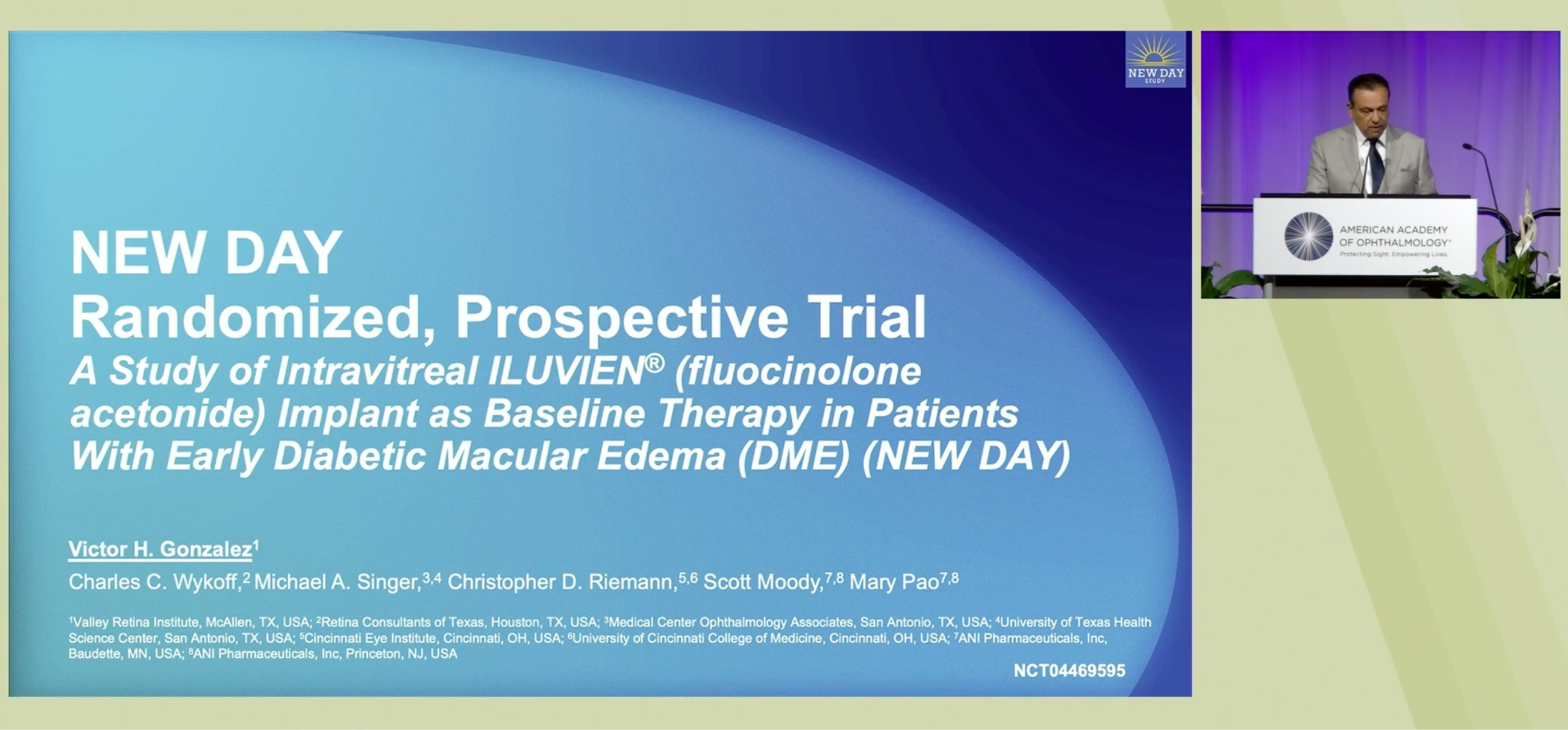Ashley Zhou, MD
PGY3 Resident
Mayo Clinic
At AAO 2025’s Retina Subspecialty Day, a pair of presentations delivered compelling new data on emerging strategies for diabetic retinopathy. Dr. Victor H. Gonzalez, from the University of Texas San Antonio, presented U.S. data for the first time from the pivotal NEW DAY trial. This prospective, randomized study compared the fluocinolone acetonide 0.19 mg intravitreal implant (Iluvien) to aflibercept in patients with center-involved diabetic macular edema (DME).

The study’s primary endpoint was the mean number of supplemental aflibercept injections required by participants through the study’s 18 month follow up period. The study found comparable supplemental injections between the two arms, with 2.4 injections needed in the fluocinolone group versus 2.5 in the aflibercept group. However, when the total injection burden was examined, the fluocinolone arm required just 3.4 total injections compared to 7.5 in the aflibercept arm, demonstrating a nearly 50% reduction during the trial period. While visual acuity gains favored aflibercept (5.5 letters versus 1.8 letters), this was largely attributed to cataract development in phakic patients receiving the steroid implant as evidenced by a subanalysis which showed similar visual outcomes across both treatment arms in pseudophakic patients.
Aflibercept produced a robust drying effect during the induction phase, but patients experienced rebound thickening of the CST in the maintenance phase. In contrast, the fluocinolone group showed steady and continued CST reduction, ending with a 50-micron advantage at month 18. Safety results aligned with known drug profiles: cataracts and IOP-related events were more common with the steroid implant. Dr. Gonzalez concluded that this prospective dataset informs the use of the fluocinolone implant, in combination with anti-VEGF bolus therapy, in the management of diabetic macular edema.
Following Dr. Gonzalez’s presentation, Dr. Charles C. Wykoff of Retina Consultants of Texas and the Blanton Eye Institute presented two-year results from the ALTITUDE trial, a phase 2 study evaluating suprachoroidal delivery of surabgene lomparvovec (Suravec, ABBV-RGX-314), an investigational anti-VEGF gene therapy, for NPDR without DME. The therapy, delivered via a single, in-office suprachoroidal injection, is designed to act as a localized biofactory producing an anti-VEGF Fab.
Two or more DRSS step improvements were observed in 50% of eyes at two years that received the treatment, compared to just 8% in historical controls, similar to Protocol W. Notably, no patients in this group showed worsening of DRSS scores. Rates of vision-threatening events (either PDR or DME) were also significantly reduced, just 14% in dose level 3, compared to 50% in standard-of-care trials, suggesting a ~70% relative risk reduction.
![]()
Safety signals were encouraging. While earlier dose levels without steroid prophylaxis saw episcleritis and mild inflammation, with the addition of a seven-week prophylactic topical steroid course for dose level 3, there were no cases of intraocular inflammation.
A thoughtful panel discussion followed, focusing on the clinical implications of early intervention in diabetic eye disease. The experts generally agreed that waiting for patients to develop DME or PDR before initiating treatment mirrors waiting for a heart attack before managing hypertension. Yet real-world barriers, including injection burden, compliance, and procedural risk, limit widespread anti-VEGF use in early NPDR which can also be managed with moderate systemic therapy as well without risking ocular complications.
Panelists also weighed in on practice patterns. While most still opt for a second anti-VEGF agent or Ozurdex before considering Iluvien, the NEW DAY trial may shift that paradigm, especially in pseudophakic eyes with high treatment burden. Focal laser also remains an option in select cases with extrafoveal microaneurysms, but not a primary tool in most practices.